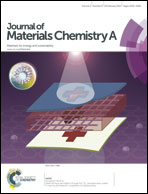Stable phase domains of the TiO2–Ti3O5–Ti2O3–TiO–Ti(CxOy)–TiC system examined experimentally and via first principles calculations
Abstract
The stable phase domains of the TiO2–Ti3O5–Ti2O3–TiO–Ti(CxOy)–TiC system were examined experimentally and using first principles calculations. The stable phase domains before, after, and during (i.e., meta-stable phases) the carbothermal reduction of TiO2 are reported here in detail because this increasingly important reaction has not been systematically studied. Stable phase domains were experimentally assessed from the isothermal study of the reduction of TiO2; the thermodynamic activities and the Gibbs free energies of the formation of TiC and TiO in Ti(CxOy) solid solution phases were calculated using the Gibbs–Duhem equation. The first principles calculations of stable-phase-domain diagrams at different temperatures were used to assess the effects of temperature. Formation energies of the solid solutions were calculated using special quasi-random structures. Zero-point energies and phonon vibration effects were calculated for the solid solutions by density perturbation theory implemented in the Vienna ab initio simulations package. A thorough understanding of the stabilities of the initial, final, and intermediate phases will allow the optimization of synthesis conditions and aid the development of new materials. Therefore, this study is expected to aid the synthesis of titanium oxides, titanium carbides, and their solid solutions for energy storage materials and other useful applications.


 Please wait while we load your content...
Please wait while we load your content...